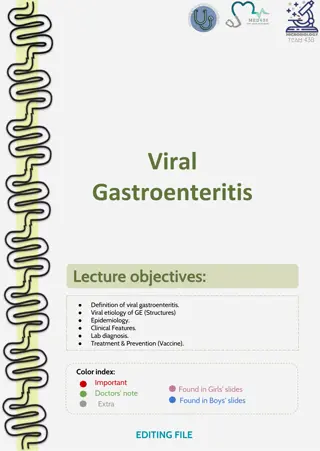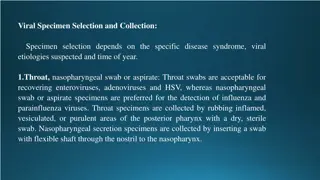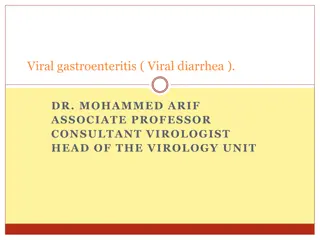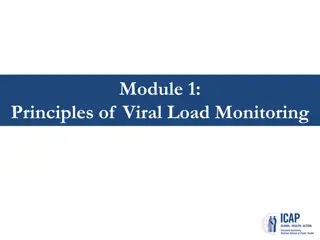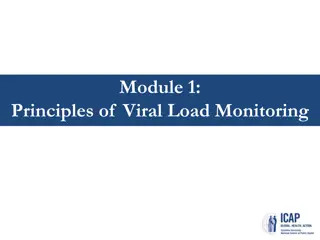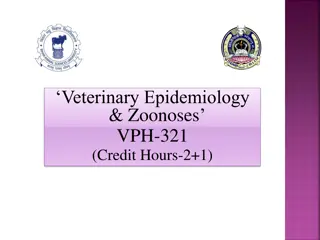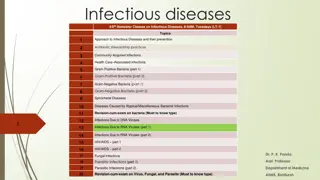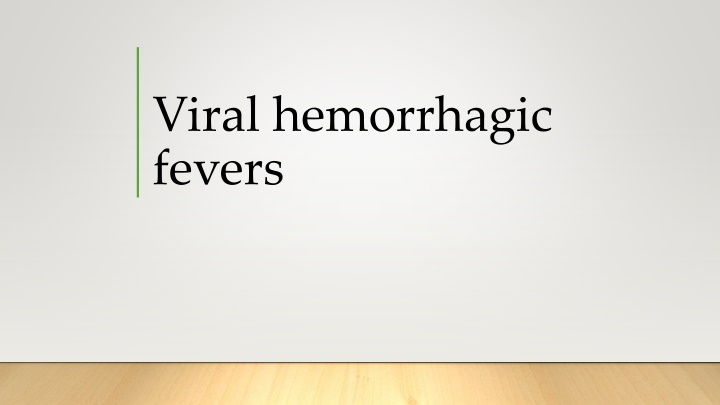
Viral Hemorrhagic Fevers and Their Causes
Viral hemorrhagic fevers (VHFs) are severe illnesses caused by enveloped viruses from four families. This article explores their evaluation, management, transmission, causes, and pathogenesis, highlighting the crucial role of an interprofessional team in patient care.
Download Presentation

Please find below an Image/Link to download the presentation.
The content on the website is provided AS IS for your information and personal use only. It may not be sold, licensed, or shared on other websites without obtaining consent from the author. If you encounter any issues during the download, it is possible that the publisher has removed the file from their server.
You are allowed to download the files provided on this website for personal or commercial use, subject to the condition that they are used lawfully. All files are the property of their respective owners.
The content on the website is provided AS IS for your information and personal use only. It may not be sold, licensed, or shared on other websites without obtaining consent from the author.
E N D
Presentation Transcript
Viral hemorrhagic fevers
Introduction Viral hemorrhagic fevers (VHFs) represent a group of severe systemic febrile illnesses caused by four families of viruses - Arenaviridae, Bunyaviridae, Filoviridae, and Flaviviridae. These enveloped viruses are characterized by a myriad of symptoms that range from coagulopathies, hemodynamic instability, altered mental status, and, if severe enough, death. This activity outlines the evaluation and management of viral hemorrhagic fevers and highlights the role of the interprofessional team in the care of patients with this condition..
Transmission Most of the viruses implicated in these diseases require vectors for transmission to humans, with the majority being arthropod-borne or rodent-borne infections. Given their zoonotic nature, these diseases are generally confined to the endemic areas where their hosts live. However, given increased human migration and further globalization, these diseases are no longer limited to their geographic origins
What causes viral hemorrhagic fevers? Bunyaviridae family Crimean-Congo hemorrhagic virus (CCHFV) - Crimean-Congo hemorrhagic fever Dobrava-Belgrade virus (DOBV) - Hemorrhagic fever with renal syndrome Filoviridae family: Bundibugyo ebolavirus (BDBV) - Ebola virus disease Marburg marburgvirus (MARV) - Marburg hemorrhagic fever Crimean-Congo hemorrhagic virus (CCHFV) - Crimean-Congo hemorrhagic fever
Bunyaviridae family: In iraq Crimean-Congo hemorrhagic virus (CCHFV) - Crimean-Congo hemorrhagic fever
Flaviviridae family: Dengue virus (DENV-1-4) - Dengue fever Kyasanur forest disease virus (KFDV) - Kyasanur forest disease Omsk hemorrhagic fever virus (OHFV) - Omsk hemorrhagic fever Yellow fever virus (YFV) - Yellow fever
Pathogenesis Pathogens implicated in viral hemorrhagic fevers are able to replicate within macrophages and dendritic cells, allowing for rapid dissemination within the host. Macrophages are triggered to release cytokines and chemokines, which cause increased vascular permeability and a procoagulant state. These viruses can also trigger mechanisms resulting in disseminated intravascular coagulation. Infected dendritic cells are impaired, and the loss of its appropriate function can lead to lymphocytic apoptosis.
What are the symptoms of viral hemorrhagic fever? Specific symptoms vary by type of viral hemorrhagic fever, but initial symptoms often include fever, fatigue, dizziness, muscle aches, loss of strength, and exhaustion. Patients with severe cases of viral hemorrhagic fever often bleed under the skin, in internal organs or from body openings. Severely ill patients may also exhibit shock, problems with the nervous system, coma, and seizures. Some types of viral hemorrhagic fever are associated with kidney failure.
The most severe complications of viral hemorrhagic fevers involve multi-organ system failure and death. Management is largely supportive. Given the risk for nosocomial infections and further outbreaks, viral hemorrhagic fever isolation precautions should be instituted immediately if this entity is suspected.
Evaluation The clinical evaluation for viral hemorrhagic fevers includes complete blood count with differential, comprehensive metabolic panel, type and cross, coagulation studies, liver function tests, as well as evaluation for bacterial infections with urinalysis, urine culture, chest x-ray, and blood cultures. Serological testing for virus-specific IgM and IgG can be helpful but is not as sensitive or specific as molecular-based polymerase chain reaction and virus isolation via cell culture are methods that can be used for diagnostic testing. testing. Reverse transcriptase-
In Iraq Between 1 January to 22 May 2022, the health authorities of the Republic of Iraq notified WHO of 212 cases of Crimean-Congo Hemorrhagic Fever (CCHF), of which 115 (54%) were suspected and 97 (46%) laboratory-confirmed; there were 27 deaths, 14 in suspected cases and 13 in laboratory confirmed cases. The number of cases reported in the first five months of 2022 is much higher than that reported in 2021, when 33 laboratory confirmed cases were recorded. Cases have been reported in several areas (governorates) in Iraq and the outbreak may pose additional pressure to an already over-stretched health care system.
Distribution of laboratory confirmed cases of Crimean- Congo Hemorrhagic Fever by governorate, Iraq, 1 January to 22 May 2022 (n=97).
Among confirmed cases, most had direct contact with animals, and were livestock breeders or butchers. Just over half of the confirmed cases were 15 to 44 years old (n=52; 54%) and of male gender (n=60; 62%). Nearly 50% of confirmed cases (n=47; 48%) were reported in Thiqar governorate, southeast Iraq, and the remainder of cases were reported from 12 different governorates; Missan (13), Muthanna (7), Wassit (6), Diwaniya (4), Baghdad Karkh (4), Kirkuk (3), Basrah (3), Najaf (3), Nineveh (3), Baghdad-Rusafa (2), Babylon (1) and Karbala (1) (Figure 1).
The Best Ways To Prevent And Control Viral Fever Wash your hands: Cover your mouth and nose: Avoid direct contact with a sick person: Prevent mosquito bites Managing a viral fever







